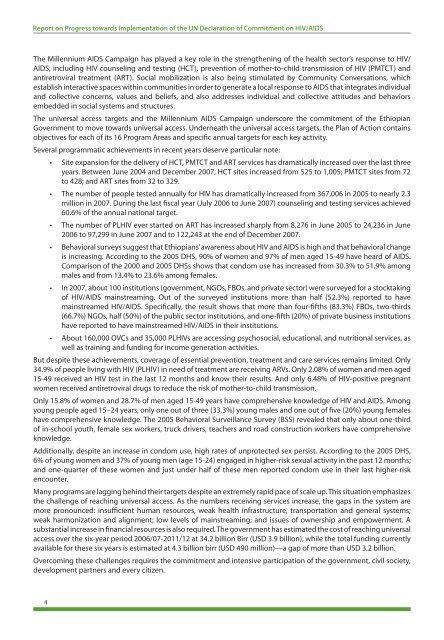Ethiopia - Country Progress Report - unaids
Ethiopia - Country Progress Report - unaids
Ethiopia - Country Progress Report - unaids
Create successful ePaper yourself
Turn your PDF publications into a flip-book with our unique Google optimized e-Paper software.
<strong>Report</strong> on <strong>Progress</strong> towards Implementation of the UN Declaration of Commitment on HIV/AIDS<br />
The Millennium AIDS Campaign has played a key role in the strengthening of the health sector’s response to HIV/<br />
AIDS, including HIV counseling and testing (HCT), prevention of mother-to-child transmission of HIV (PMTCT) and<br />
antiretroviral treatment (ART). Social mobilization is also being stimulated by Community Conversations, which<br />
establish interactive spaces within communities in order to generate a local response to AIDS that integrates individual<br />
and collective concerns, values and beliefs, and also addresses individual and collective attitudes and behaviors<br />
embedded in social systems and structures.<br />
The universal access targets and the Millennium AIDS Campaign underscore the commitment of the <strong>Ethiopia</strong>n<br />
Government to move towards universal access. Underneath the universal access targets, the Plan of Action contains<br />
objectives for each of its 16 Program Areas and specific annual targets for each key activity.<br />
Several programmatic achievements in recent years deserve particular note:<br />
• Site expansion for the delivery of HCT, PMTCT and ART services has dramatically increased over the last three<br />
years. Between June 2004 and December 2007, HCT sites increased from 525 to 1,005; PMTCT sites from 72<br />
to 428; and ART sites from 32 to 329.<br />
• The number of people tested annually for HIV has dramatically increased from 367,006 in 2005 to nearly 2.3<br />
million in 2007. During the last fiscal year (July 2006 to June 2007) counseling and testing services achieved<br />
60.6% of the annual national target.<br />
• The number of PLHIV ever started on ART has increased sharply from 8,276 in June 2005 to 24,236 in June<br />
2006 to 97,299 in June 2007 and to 122,243 at the end of December 2007.<br />
• Behavioral surveys suggest that <strong>Ethiopia</strong>ns’ awareness about HIV and AIDS is high and that behavioral change<br />
is increasing. According to the 2005 DHS, 90% of women and 97% of men aged 15-49 have heard of AIDS.<br />
Comparison of the 2000 and 2005 DHSs shows that condom use has increased from 30.3% to 51.9% among<br />
males and from 13.4% to 23.6% among females.<br />
• In 2007, about 100 institutions (government, NGOs, FBOs, and private sector) were surveyed for a stocktaking<br />
of HIV/AIDS mainstreaming. Out of the surveyed institutions more than half (52.3%) reported to have<br />
mainstreamed HIV/AIDS. Specifically, the result shows that more than four-fifths (83.3%) FBOs, two-thirds<br />
(66.7%) NGOs, half (50%) of the public sector institutions, and one-fifth (20%) of private business institutions<br />
have reported to have mainstreamed HIV/AIDS in their institutions.<br />
• About 160,000 OVCs and 35,000 PLHIVs are accessing psychosocial, educational, and nutritional services, as<br />
well as training and funding for income generation activities.<br />
But despite these achievements, coverage of essential prevention, treatment and care services remains limited. Only<br />
34.9% of people living with HIV (PLHIV) in need of treatment are receiving ARVs. Only 2.08% of women and men aged<br />
15-49 received an HIV test in the last 12 months and know their results. And only 6.48% of HIV-positive pregnant<br />
women received antiretroviral drugs to reduce the risk of mother-to-child transmission.<br />
Only 15.8% of women and 28.7% of men aged 15-49 years have comprehensive knowledge of HIV and AIDS. Among<br />
young people aged 15–24 years, only one out of three (33.3%) young males and one out of five (20%) young females<br />
have comprehensive knowledge. The 2005 Behavioral Surveillance Survey (BSS) revealed that only about one-third<br />
of in-school youth, female sex workers, truck drivers, teachers and road construction workers have comprehensive<br />
knowledge.<br />
Additionally, despite an increase in condom use, high rates of unprotected sex persist. According to the 2005 DHS,<br />
6% of young women and 37% of young men (age 15-24) engaged in higher-risk sexual activity in the past 12 months;<br />
and one-quarter of these women and just under half of these men reported condom use in their last higher-risk<br />
encounter.<br />
Many programs are lagging behind their targets despite an extremely rapid pace of scale up. This situation emphasizes<br />
the challenge of reaching universal access. As the numbers receiving services increase, the gaps in the system are<br />
more pronounced: insufficient human resources, weak health infrastructure, transportation and general systems;<br />
weak harmonization and alignment; low levels of mainstreaming; and issues of ownership and empowerment. A<br />
substantial increase in financial resources is also required. The government has estimated the cost of reaching universal<br />
access over the six-year period 2006/07-2011/12 at 34.2 billion Birr (USD 3.9 billion), while the total funding currently<br />
available for these six years is estimated at 4.3 billion birr (USD 490 million)—a gap of more than USD 3.2 billion.<br />
Overcoming these challenges requires the commitment and intensive participation of the government, civil society,<br />
development partners and every citizen.<br />
4

















